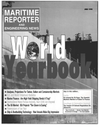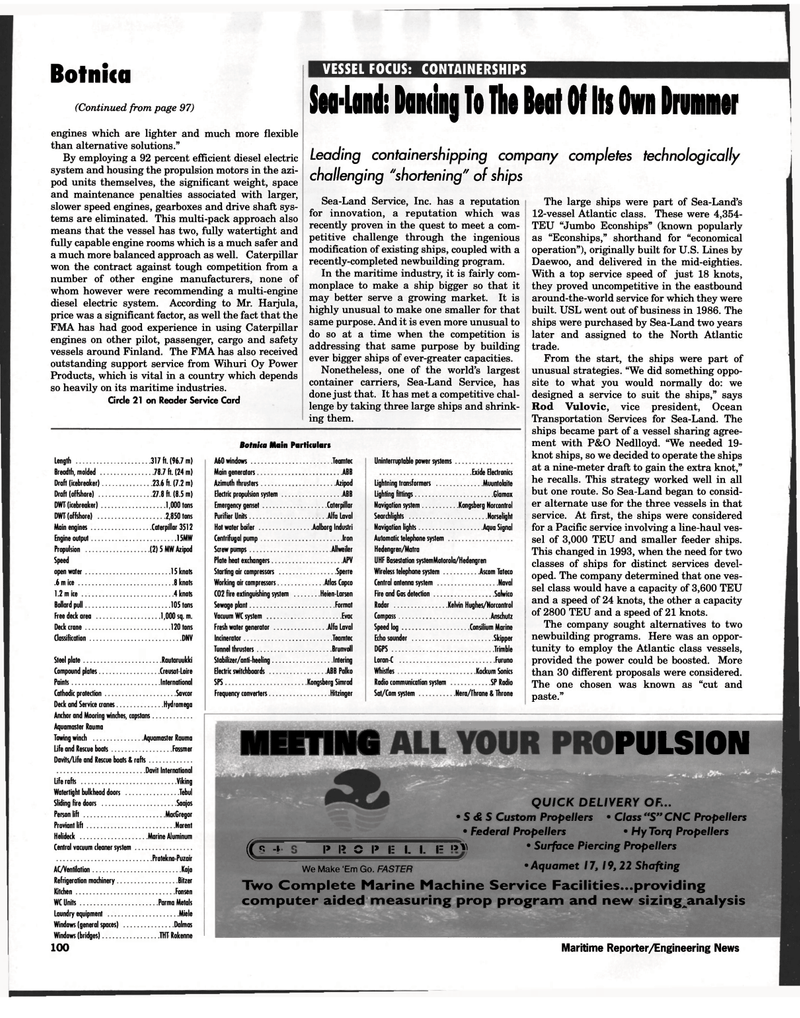
Page 98: of Maritime Reporter Magazine (June 1998)
Read this page in Pdf, Flash or Html5 edition of June 1998 Maritime Reporter Magazine
Botnica (Continued from page 97) engines which are lighter and much more flexible than alternative solutions."
By employing a 92 percent efficient diesel electric system and housing the propulsion motors in the azi- pod units themselves, the significant weight, space and maintenance penalties associated with larger, slower speed engines, gearboxes and drive shaft sys- tems are eliminated. This multi-pack approach also means that the vessel has two, fully watertight and fully capable engine rooms which is a much safer and a much more balanced approach as well. Caterpillar won the contract against tough competition from a number of other engine manufacturers, none of whom however were recommending a multi-engine diesel electric system. According to Mr. Haijula, price was a significant factor, as well the fact that the
FMA has had good experience in using Caterpillar engines on other pilot, passenger, cargo and safety vessels around Finland. The FMA has also received outstanding support service from Wihuri Oy Power
Products, which is vital in a country which depends so heavily on its maritime industries.
Circle 21 on Reader Service Card
VESSEL FOCUS: CONTAINERSHIPS
Sea-land: Darning To Ae Beat (I lis Own Drummer
Leading containershipping company completes technologically challenging "shortening" of ships
Sea-Land Service, Inc. has a reputation for innovation, a reputation which was recently proven in the quest to meet a com- petitive challenge through the ingenious modification of existing ships, coupled with a recently-completed newbuilding program.
In the maritime industry, it is fairly com- monplace to make a ship bigger so that it may better serve a growing market. It is highly unusual to make one smaller for that same purpose. And it is even more unusual to do so at a time when the competition is addressing that same purpose by building ever bigger ships of ever-greater capacities.
Nonetheless, one of the world's largest container carriers, Sea-Land Service, has done just that. It has met a competitive chal- lenge by taking three large ships and shrink- ing them.
Length 317 ft. (96.7 m)
Breadth, molded 78.7 ft. (24 m)
Draft (icebreaker) 23.6 ft. (7.2 m)
Draft (offshore) 27.8 ft. (8.5 m)
DWT (icebreaker) 1,000 tons
DWT (offshore) 2,850 tons
Main engines Caterpillar 3512
Engine output 15MW
Propulsion (2) 5 MW Azipod
Speed open water 15 knots .6mice 8knot 1.2mice 4knots
Bollard pull 105 tons
Free deck area 1,000 sq.m.
Deck crane 120 tons
Classification DNV
Steel plate Rautaruukki
Compound plates Creusot-Loire
Paints International
Cathodic protection Savcor
Deck and Service cranes Hydromega
Anchor and Mooring winches, capstans
Aquamaster Rauma
Towing winch Aquamaster Rauma life and Rescue boats Fassmer
Davits/Life and Rescue boats & rafts
Davit International
Life rafts Viking
Watertight bulkhead doors Tebul
Sliding fire doors Saajos
Person lift MacGregor
Proviant lift Norent
Helideck Marine Aluminum
Central vacuum cleaner system
Protekno-Puzair
ACAentilation Kojo
Refrigeration machinery Bitzer
Kitchen Fonsen
WC Units Parma Metals
Laundry equipment Miele
Windows (general spaces) Dalmas
Windows (bridges) TUT Rokenne 100
Bolnita Main Particulars
A60 windows Teamtec
Main generators ABB
Azimuth thrusters Azipod
Electric propulsion system ABB
Emergency genset Caterpillar
Purifier Units Alfa Laval
Hot water boiler Aalborg Industri
Centrifugal pump Iron
Screw pumps Allweiler
Plate heat exchangers APV
Starting air compressors Sperre
Working air compressors Atlas Copco
C02 fire extinguishing system Heien-Larsen
Sewage plant Format
Vacuum WC system Evac
Fresh water generator Alfa Laval
Incinerator Teamtec
Tunnel thrusters Brunvoll
Stabilizer/anti-heeling Intering
Electric switchboards ABB Palko
SPS Kongsberg Simrad
Frequency converters Hitzinger
Uninterruptable power systems
Exide Electronics
Lightning transformers Muuntolaite
Lighting fittings Glamox
Navigation system Kongsberg Norcontrol
Searchlights Norselight
Navigation lights Aqua Signal
Automatic telephone system
Hedengren/Matra
UHF Basestation systemMotorola/Hedengren
Wireless telephone system Ascom Tateco
Central antenna system Naval
Fire and Gas detection Salwico
Radar Kelvin Hughes/Norcontrol
Compass Anschutz
Speed log Consilium Marine
Echo sounder Skipper
DGPS Trimble
Loran-C Furuno
Whistles KockumSonics
Radio communication system SP Radio
Sat/Com system Nera/Fhrane & Throne
The large ships were part of Sea-Land's 12-vessel Atlantic class. These were 4,354-
TEU "Jumbo Econships" (known popularly as "Econships," shorthand for "economical operation"), originally built for U.S. Lines by
Daewoo, and delivered in the mid-eighties.
With a top service speed of just 18 knots, they proved uncompetitive in the eastbound around-the-world service for which they were built. USL went out of business in 1986. The ships were purchased by Sea-Land two years later and assigned to the North Atlantic trade.
From the start, the ships were part of unusual strategies. "We did something oppo- site to what you would normally do: we designed a service to suit the ships," says
Rod Vulovic, vice president, Ocean
Transportation Services for Sea-Land. The ships became part of a vessel sharing agree- ment with P&O Nedlloyd. "We needed 19- knot ships, so we decided to operate the ships at a nine-meter draft to gain the extra knot," he recalls. This strategy worked well in all but one route. So Sea-Land began to consid- er alternate use for the three vessels in that service. At first, the ships were considered for a Pacific service involving a line-haul ves- sel of 3,000 TEU and smaller feeder ships.
This changed in 1993, when the need for two classes of ships for distinct services devel- oped. The company determined that one ves- sel class would have a capacity of 3,600 TEU and a speed of 24 knots, the other a capacity of 2800 TEU and a speed of 21 knots.
The company sought alternatives to two newbuilding programs. Here was an oppor- tunity to employ the Atlantic class vessels, provided the power could be boosted. More than 30 different proposals were considered.
The one chosen was known as "cut and paste."
MEETING PULSION < R -I P I? C P IE I. I. I
QUICK DELIVERY OF... • S & S Custom Propellers • Class "S" CNC Propellers • Federal Propellers • Hy Torq Propellers z • Surface Piercing Propellers •Aquamet 17, 19,22 Shafting We Make 'Em Go. FASTER
Two Complete Marine Machine Service Facilities...providing computer aided measuring prop program and new sizing analysis
Maritime Reporter/Engineering News

 97
97

 99
99
